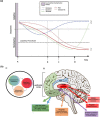Neurocognitive Precursors of Substance Misuse Corresponding to Risk, Resistance, and Resilience Pathways: Implications for Prevention Science
- PMID: 31258493
- PMCID: PMC6586742
- DOI: 10.3389/fpsyt.2019.00399
Neurocognitive Precursors of Substance Misuse Corresponding to Risk, Resistance, and Resilience Pathways: Implications for Prevention Science
Erratum in
-
Corrigendum: Neurocognitive Precursors of Substance Misuse Corresponding to Risk, Resistance, and Resilience Pathways: Implications for Prevention Science.Front Psychiatry. 2020 Feb 14;11:57. doi: 10.3389/fpsyt.2020.00057. eCollection 2020. Front Psychiatry. 2020. PMID: 32116861 Free PMC article.
Abstract
Studies of substance misuse prevention generally focus on characteristics that typify risk, with the assumption that the prevalence of the problem will be optimally reduced by identifying, targeting, and reducing or eliminating risk factors. However, this risk-centered approach neglects variations in individual-level and environmental characteristics that portend differential pathways that are distinguishable by timing of substance use initiation (e.g., early versus delayed), the likelihood of use escalation versus eventual desistance, and enduring abstinence, despite exposure to significant risk factors. Considering the various underpinnings of these distinct substance use trajectories is critical to a more nuanced understanding of the effects, potency, and malleability of factors that are known to increase risk or confer protection. Here, we discuss three pathways relative to substance use patterns and predictors in the context of adversity, a well-known, highly significant influence on propensity for substance misuse. The first pathway is designated as "high risk" based on early onset of substance use, rapid escalation, and proneness to substance use disorders. Individuals who defy all odds and eventually exhibit adaptive developmental outcomes despite an initial maladaptive reaction to adversity, are referred to as "resilient." However, another categorization that has not been adequately characterized is "resistant." Resistant individuals include those who do not exhibit problematic substance use behaviors (e.g., early onset and escalation) and do not develop substance use disorders or other forms of psychopathology, despite significant exposure to factors that normally increase the propensity for such outcomes (e.g. trauma and/or adversity). In this paper, we apply this conceptualization of risk, resistance, and resilience for substance misuse to a more fine-grained analysis of substance use pathways and their corresponding patterns (e.g., non-use, initiation, escalation, desistance). The significance of the progression of neurocognitive functioning over the course of development is discussed as well as how this knowledge may be translated to make a science-based determination of intervention targets. This more encompassing theoretical model has direct implications for primary prevention and clinical approaches to disrupt risk pathways and to optimize long-term outcomes.
Keywords: neurocognitive; neuroimaging; prevention science; resilience; resistance; risk; substance misuse/abuse.
Figures


References
-
- Conway KP, Swendsen J, Husky MM, He JP, Merikangas KR. Association of lifetime mental disorders and subsequent alcohol and illicit drug use: results from the National Comorbidity Survey–Adolescent Supplement. J Am Acad Child Adolesc Psychiatry (2016) 55(4):280–8. 10.1016/j.jaac.2016.01.006 - DOI - PubMed
Publication types
Grants and funding
LinkOut - more resources
Full Text Sources

